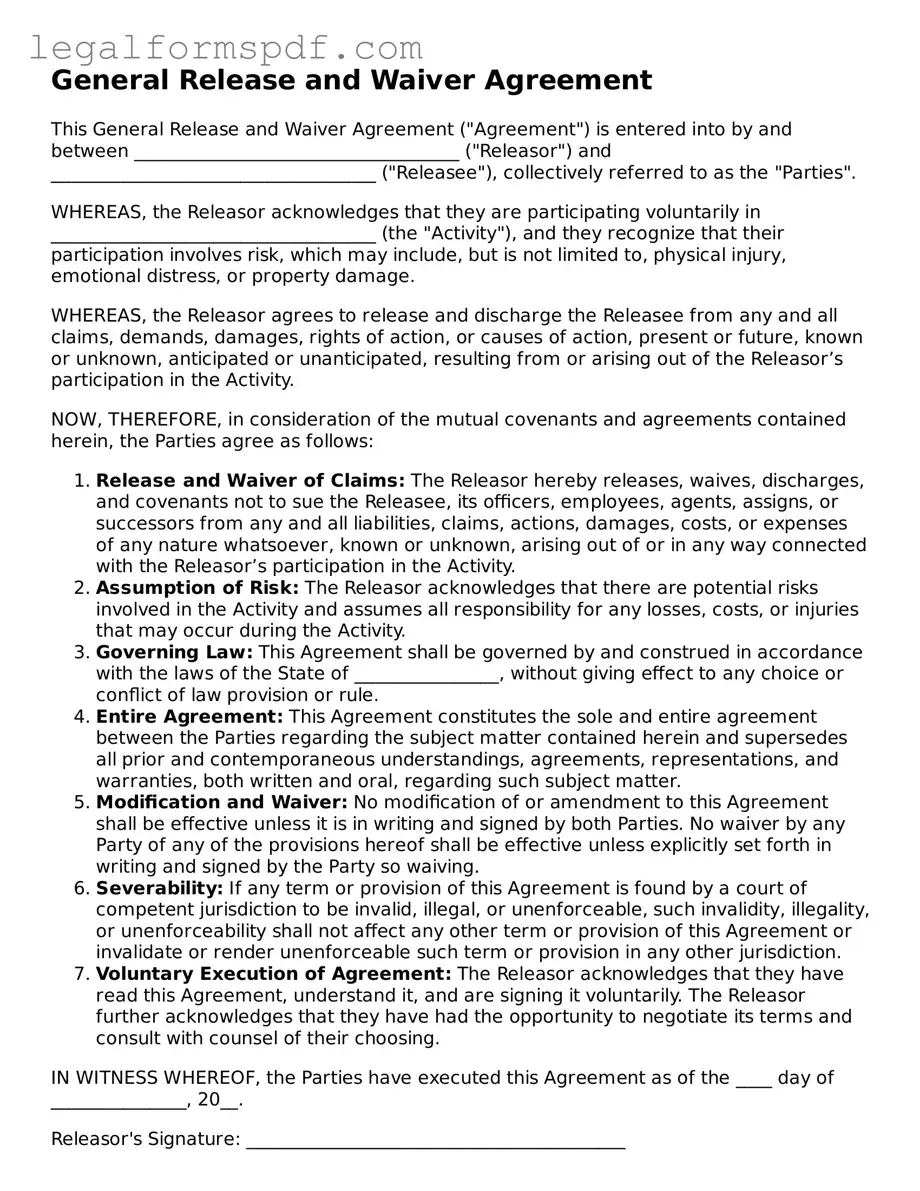General Release and Waiver Agreement
This General Release and Waiver Agreement ("Agreement") is entered into by and between ____________________________________ ("Releasor") and
____________________________________ ("Releasee"), collectively referred to as the "Parties".
WHEREAS, the Releasor acknowledges that they are participating voluntarily in ____________________________________ (the "Activity"), and they recognize that their participation involves risk, which may include, but is not limited to, physical injury, emotional distress, or property damage.
WHEREAS, the Releasor agrees to release and discharge the Releasee from any and all claims, demands, damages, rights of action, or causes of action, present or future, known or unknown, anticipated or unanticipated, resulting from or arising out of the Releasor’s participation in the Activity.
NOW, THEREFORE, in consideration of the mutual covenants and agreements contained herein, the Parties agree as follows:
- Release and Waiver of Claims: The Releasor hereby releases, waives, discharges, and covenants not to sue the Releasee, its officers, employees, agents, assigns, or successors from any and all liabilities, claims, actions, damages, costs, or expenses of any nature whatsoever, known or unknown, arising out of or in any way connected with the Releasor’s participation in the Activity.
- Assumption of Risk: The Releasor acknowledges that there are potential risks involved in the Activity and assumes all responsibility for any losses, costs, or injuries that may occur during the Activity.
- Governing Law: This Agreement shall be governed by and construed in accordance with the laws of the State of ________________, without giving effect to any choice or conflict of law provision or rule.
- Entire Agreement: This Agreement constitutes the sole and entire agreement between the Parties regarding the subject matter contained herein and supersedes all prior and contemporaneous understandings, agreements, representations, and warranties, both written and oral, regarding such subject matter.
- Modification and Waiver: No modification of or amendment to this Agreement shall be effective unless it is in writing and signed by both Parties. No waiver by any Party of any of the provisions hereof shall be effective unless explicitly set forth in writing and signed by the Party so waiving.
- Severability: If any term or provision of this Agreement is found by a court of competent jurisdiction to be invalid, illegal, or unenforceable, such invalidity, illegality, or unenforceability shall not affect any other term or provision of this Agreement or invalidate or render unenforceable such term or provision in any other jurisdiction.
- Voluntary Execution of Agreement: The Releasor acknowledges that they have read this Agreement, understand it, and are signing it voluntarily. The Releasor further acknowledges that they have had the opportunity to negotiate its terms and consult with counsel of their choosing.
IN WITNESS WHEREOF, the Parties have executed this Agreement as of the ____ day of _______________, 20__.
Releasor's Signature: __________________________________________
Print Name: __________________________________________________
Releasee's Signature: __________________________________________
Print Name: __________________________________________________
